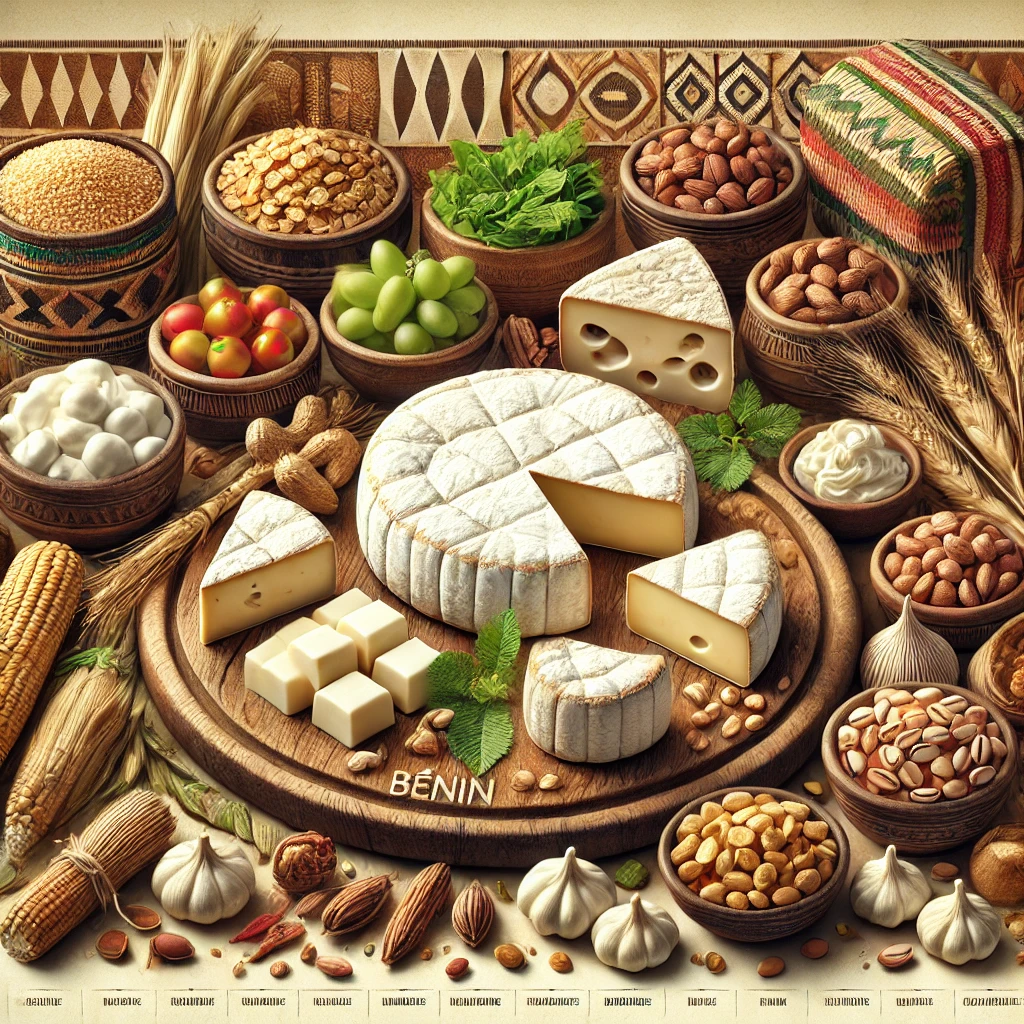Le fromage de brebis traditionnel du Bénin est l’un des trésors les plus discrets de l’Afrique de l’Ouest. Bien moins connu que les fromages européens ou même que certains fromages de vache africains, il occupe pourtant une place importante dans les communautés pastorales et rurales béninoises.
Fabriqué de manière artisanale à partir de lait de brebis, ce fromage reflète une tradition ancienne fondée sur la simplicité, l’autosuffisance et l’adaptation au climat tropical. Il n’est ni standardisé ni industrialisé, mais transmis par le savoir-faire oral, souvent de génération en génération.
Contexte Géographique et Culturel
Le Bénin, situé en Afrique de l’Ouest, possède une diversité culturelle remarquable. Dans certaines régions rurales et semi-arides, l’élevage de petits ruminants comme les brebis joue un rôle clé dans la sécurité alimentaire.
Le fromage de brebis est principalement produit :
-
Dans les zones rurales
-
Par des familles d’éleveurs
-
À petite échelle, pour la consommation locale
Il s’inscrit dans une culture où rien n’est gaspillé, et où le lait est transformé rapidement pour éviter la perte.
Origines Historiques du Fromage de Brebis au Bénin
La fabrication du fromage au Bénin ne résulte pas d’une influence européenne directe, mais d’une évolution locale des pratiques pastorales africaines. Les communautés ont développé des techniques de transformation du lait pour :
-
Prolonger sa durée de consommation
-
Faciliter son transport
-
Apporter des protéines aux régimes à base de céréales
Le fromage de brebis est ainsi né comme un aliment fonctionnel, avant d’être un produit gastronomique.
Pourquoi Utiliser le Lait de Brebis ?
Le lait de brebis est particulièrement adapté aux conditions béninoises.
Avantages du lait de brebis
-
Plus riche en matières grasses
-
Saveur naturellement prononcée
-
Bonne coagulation sans techniques complexes
-
Adapté aux petits troupeaux
Ces caractéristiques permettent de produire un fromage nourrissant même avec de faibles quantités de lait.
Ingrédients Traditionnels
Le fromage de brebis traditionnel du Bénin repose sur une liste d’ingrédients minimale.
Ingrédients de base
-
Lait frais de brebis
-
Agent coagulant naturel (lait aigre, chaleur ou extrait végétal)
-
Sel (optionnel)
Aucun additif industriel ni ferment commercial n’utilisé.
Méthode de Fabrication Traditionnelle
La fabrication est simple, mais exige de l’expérience.
Étapes Traditionnelles
-
Traite et Filtration
Le lait est collecté et filtré pour éliminer les impuretés. -
Coagulation
Le lait est chauffé doucement ou mélangé à un agent coagulant naturel. -
Séparation du Caillé
Le caillé se forme et se sépare du petit-lait. -
Égouttage
Le caillé est placé dans un tissu pour éliminer l’excès de liquide. -
Façonnage
Le fromage est moulé à la main en petites formes. -
Séchage Léger (optionnel)
Dans certaines régions, un séchage à l’air prolonge la conservation.
Le fromage est généralement consommé frais ou légèrement affermi.
Texture et Apparence
| Caractéristique | Description |
|---|---|
| Texture | Molle à semi-ferme |
| Humidité | Moyenne |
| Couleur | Blanc à ivoire |
| Forme | Petits blocs ou boules |
| Croûte | Absente ou naturelle |
Son aspect est rustique, reflet de sa fabrication artisanale.
Profil de Goût du Fromage de Brebis Béninois
Le goût du fromage de brebis traditionnel du Bénin est authentique et expressif.
Notes Gustatives
-
Légèrement acidulé
-
Saveur marquée de lait de brebis
-
Doux à moyennement salé
-
Finale rustique et naturelle
Il est plus prononcé qu’un fromage de vache frais, mais reste équilibré.
Variantes Dépendant des Régions
Il n’existe pas de recette unique.
Variantes Courantes
-
Fromage très frais : doux et crémeux
-
Fromage légèrement séché : plus ferme, goût concentré
-
Version salée : meilleure conservation
Ces différences reflètent le climat, les habitudes et les besoins locaux.
Usages Culinaires Traditionnels
Le fromage de brebis est rarement consommé seul.
Utilisations Courantes
-
Émietté dans les sauces
-
Accompagnant les bouillies de mil ou de sorgho
-
Servi avec des tubercules (igname, manioc)
-
Intégré aux plats de légumes
Il apporte protéines et onctuosité aux repas quotidiens.
Usages Modernes et Réinterprétations
Avec l’intérêt croissant pour les cuisines africaines traditionnelles, ce fromage attire l’attention.
Applications Modernes
-
Cuisine africaine contemporaine
-
Menus gastronomiques axés sur le terroir
-
Alimentation durable et locale
Son authenticité est un atout majeur.
Accords Alimentaires
Accompagnements Traditionnels
-
Pâte de maïs ou de mil
-
Légumes verts cuits
-
Sauces légèrement épicées
Éléments d’Équilibre
-
Huiles végétales
-
Oignons cuits
-
Tomates
Ces ingrédients adoucissent son caractère.
Valeur Nutritionnelle
Le fromage de brebis béninois est dense sur le plan nutritionnel.
Bienfaits Nutritionnels
-
Protéines complètes
-
Calcium et phosphore
-
Matières grasses naturelles
-
Énergie durable
Il est particulièrement utile dans les zones à accès limité aux protéines animales.
Fromage de Brebis vs Fromage de Vache au Bénin
| Critère | Brebis | Vache |
|---|---|---|
| Goût | Plus intense | Plus doux |
| Richesse | Élevée | Moyenne |
| Quantité de lait | Faible | Plus élevée |
| Usage | Fonctionnel | Plus répandu |
Le fromage de brebis reste plus rare mais très apprécié.
Achat et Conservation
Conseils d’Achat
-
Privilégier les producteurs locaux
-
Vérifier l’odeur fraîche
-
Éviter l’humidité excessive
Conservation
-
Consommer rapidement
-
Garder au frais si possible
-
Séchage léger pour une durée plus longue
Ce fromage n’est pas destiné à une conservation prolongée.
Importance Culturelle Aujourd’hui
Le fromage de brebis traditionnel du Bénin symbolise :
-
La résilience rurale
-
Le savoir-faire féminin
-
La valorisation des ressources locales
Il est un témoin vivant de la culture alimentaire béninoise.
Pourquoi Ce Fromage Mérite Plus de Reconnaissance
À l’ère de la mondialisation alimentaire, ce fromage rappelle que :
-
La tradition peut être durable
-
La simplicité peut être nutritive
-
Les fromages africains ont une vraie identité
Il mérite une place dans les discussions sur le patrimoine gastronomique mondial.
Conclusion
Le fromage de brebis traditionnel du Bénin est bien plus qu’un simple produit laitier. Il incarne l’histoire, l’adaptation et l’ingéniosité des communautés rurales béninoises. Fabriqué avec peu de moyens mais beaucoup de savoir, il nourrit les corps autant que la culture.
Redécouvrir ce fromage, c’est reconnaître la richesse des traditions alimentaires africaines et leur rôle essentiel dans un futur plus durable et respectueux des terroirs.
Foire Aux Questions (FAQ)
De quoi est fait le fromage de brebis béninois ?
Il est fabriqué à partir de lait frais de brebis et de coagulants naturels.
Est-il affiné longtemps ?
Non, il est généralement consommé frais ou légèrement séché.
Quel est son goût ?
Il est légèrement acidulé, avec une saveur marquée de lait de brebis.
Comment est-il consommé traditionnellement ?
Il est intégré aux plats, sauces et bouillies locales.
Est-il facile à trouver hors du Bénin ?
Non, il est majoritairement produit et consommé localement.



